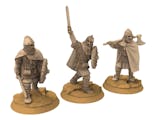Printed in solid non-hollowed resin (no holes).
Good quality resin (40€/kg).
Bases not supplied (in yellow).
Randomly packaged.
28mm scale (for Lotr/D&D).
These models were made by Medbury miniatures and are sold under license.
https://www.patreon.com/medburyminiatures/posts
The Vendel Era was a turbulent period in Northern Europe from the late 5th to the mid-8th centuries AD. During this time, Germanic tribes such as the Goths, Vandals, and Lombards migrated across Europe, causing political and social upheaval. The Vandals were a Germanic tribe that originated in what is now modern-day Poland and migrated southward into Eastern Europe. In the 5th century AD, the Vandals invaded the Roman Empire and established their kingdom in North Africa. However, they faced a series of conflicts with the Romans and their allies, including the Byzantine Empire, the Visigoths, and the Berbers.
The Vandals also faced internal strife, including a succession crisis and a civil war that weakened their military power. In the mid-6th century, the Byzantine general Belisarius defeated the Vandals and re-established Roman control over North Africa. The Lombards were another Germanic tribe that migrated to Italy and established their own kingdom in the 6th century. They faced numerous conflicts with the Byzantine Empire, the Papacy, and other Italian tribes, including the Franks and the Saxons. The Lombards also faced internal power struggles and territorial disputes that weakened their kingdom. Despite these challenges, the Lombards managed to maintain their independence until the 8th century, when they were conquered by the Franks.
The Goths were a Germanic tribe that played a significant role in the fall of the Western Roman Empire in the 5th century AD. They established their own kingdoms in Italy, Spain, and Southern France, but faced numerous conflicts with the Byzantines and other Germanic tribes. The Goths also faced internal power struggles and religious disputes that weakened their kingdoms and made them vulnerable to conquest. The Vendel Era was a period of great change and conflict for the Germanic tribes, as they struggled to establish their own kingdoms and resist the expanding power of the Byzantine Empire and other European powers.
The Vendel Era saw a significant amount of cultural exchange between the Germanic tribes and the surrounding civilizations, such as the Roman Empire and Byzantine Empire. The influx of Christian missionaries during this time also played a significant role in shaping the religious beliefs and practices of the Germanic tribes. The spread of Christianity led to the conversion of many Germanic kings and leaders, including King Clovis of the Franks. The Vendel Era also witnessed the rise of the Avars, a nomadic people from Central Asia, who would eventually become a major power in Europe.
The Avars launched multiple invasions of Germanic territories, leading to widespread destruction and displacement of populations. Despite the challenges and tribulations faced during the Vendel Era, it was also a period of significant cultural and artistic achievement, as seen in the intricate metalwork and ornate jewelry produced by the Germanic tribes. The Vendel Era ultimately paved the way for the Viking Age, as the various Germanic tribes developed the seafaring skills and technology necessary for long-distance voyages. The legacy of the Vendel Era can still be seen in many aspects of modern culture, including popular literature, film, and television that draw inspiration from the legends and folklore of the Germanic peoples. The Vendel Era remains a fascinating and complex period in European history, and its study provides valuable insights into the origins of many modern-day cultural, political, and religious traditions.
By studying the tribulations and triumphs of the Germanic tribes during the Vendel Era, we can gain a deeper understanding of the complex and multifaceted history of Europe and the world.




















